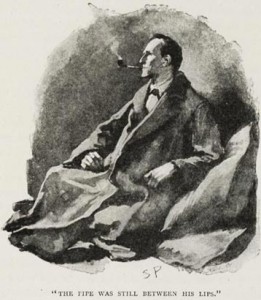Sherlock Holmes: Case Of The Bermuda NCO
 It was elementary — when Victorian medical student Arthur Conan Doyle heard his professor deduce that a patient he had not yet examined had become ill while serving in the British military in Bermuda, the idea of Sherlock Holmes was born.
It was elementary — when Victorian medical student Arthur Conan Doyle heard his professor deduce that a patient he had not yet examined had become ill while serving in the British military in Bermuda, the idea of Sherlock Holmes was born.
In an 1892 interview with “The Bookman” literary journal, Conan Doyle [1859-1930] — who began writing the adventures of the London-based “consulting detective” five years earlier — recounted the origins of the immortal literary character [seen here in artwork by original 19th century illustrator Sidney Paget].
“Oh! But, if you please, he is not evolved out of any one’s inner consciousness,” he told the magazine. “Sherlock Holmes is the literary embodiment, if I may so express it, of my memory of a professor of medicine [Dr. Joseph Bell] at Edinburgh University, who would sit in the patients’ waiting-room with a face like a Red Indian and diagnose the people as they came in, before even they had opened their mouths.
“He would tell them their symptoms, he would give them details of their lives, and he would hardly ever make a mistake. ‘Gentlemen,’ he would say to us students standing around, ‘ I am not quite sure whether this man is a cork-cutter or a slater. I observe a slight callus, or hardening, on one side of his forefinger, and a little thickening on the outside of his thumb, and that is a sure sign he is either one or the other.’
“His great faculty of deduction was at times highly dramatic …”
Dr. Bell and the case of the Bermuda NCO
“…’Ah!’ he would say to another man, ‘you are a soldier, a non-commissioned officer, and you have served in Bermuda. Now how did I know that, gentlemen? He came into the room without taking his hat off, as he would go into an orderly room. He was a soldier. A slight authoritative air, combined with his age, shows that we was an N.C.O. A slight rash on the forehead tells me he was in Bermuda, and subject to a certain rash known only there’.
“So I got the idea for Sherlock Holmes.”
– Arthur Conan Doyle
Scottish-born Dr. Bell [1837–1911] — who has been described as “a master at observation, logic, deduction, and diagnosis” –is widely considered one of the pioneers of forensic pathology.
At a time when science was not yet widely used in criminal investigations, he was regularly consulted by the Scottish and English police for his expert advice.
A number of historians have suggested Scotland Yard turned to Dr. Bell for help during Jack The Ripper’s 1888 reign of terror in London’s East End although the evidence for this seems purely circumstantial; when that infamous murder spree ended as abruptly as it began, some British newspapers suggested the serial killer had fled to Bermuda aboard a ship departing from London.
All of Dr. Bell’s deductive qualities were later to be incorporated into the persona of the celebrated detective Sherlock Holmes by his one-time clerk and student Arthur Conan Doyle.
Holmes was featured in four novels and 56 short stories. The character grew tremendously in popularity with the first series of short stories in “The Strand Magazine”, beginning with “A Scandal in Bohemia” in 1891; further series of short stories and two novels published in serial form appeared between then and 1927.
The stories cover a period from around 1880 up to 1914. Bermuda is referenced in one of the short stories — “The Boscombe Valley Mystery” [1891] — when it is revealed one of the characters has a husband serving at the Royal Naval Dockyard.
Sherlock Holmes and Dr. John Watson as depicted by Sidney Paget in ”The Adventure of Silver Blaze”
The eccentric pipe smoking resident of 221b Baker Street, London was a Bohemian who alternated between days or weeks of listless lassitude and similar periods of intense engagement with a challenging case or with his hobby — experimental chemistry — or with his violin. He was an occasional user of cocaine.
Holmes’s primary intellectual detection method is abductive reasoning. “From a drop of water,” he says in one story, “a logician could infer the possibility of an Atlantic or a Niagara without having seen or heard of one or the other”.
The “Guinness World Records” has consistently listed Sherlock Holmes as the “most portrayed movie character”with more than 70 actors playing the part in over 200 films.
Holmes’s first screen appearance was in the Mutoscope film “Sherlock Holmes Baffled” in 1900.
More recently Robert Downey Jr. has portrayed Holmes in two steampunk-flavoured motion pictures with Jude Law playing the detective’s friend and assistant Dr. John Watson.
Benedict Cumberbatch plays a modern-day version of the detective, with Martin Freeman as Watson, in the BBC One TV series “Sherlock”, which premiered on 25 July 2010. The series changes the books’ original Victorian setting to the shady and violent present-day London.
“Sherlock Holmes: The True Story of Dr. Joseph Bell” documentary
An American version of the Cumberbatch series, “Elementary”, premiered on CBS in September, 2012. Set in modern day New York, that show stars Jonny Lee Miller as recovering British drug addict Sherlock Holmes and Lucy Liu as Dr. Joan Watson.
The character in the Fox TV show “House” — which ran from 2004 to 2012 — was modelled on the brilliant but flawed consulting detective; series creator David Shore has even said that Dr. Gregory House’s name was a deliberate play on “Holmes”
Read More About
Category: All, Entertainment, Films/Movies, History


